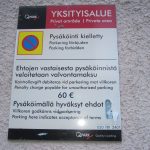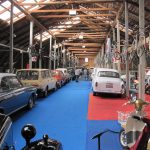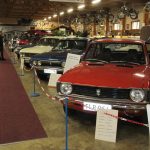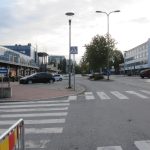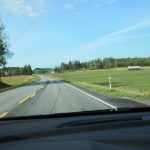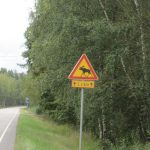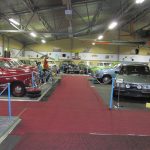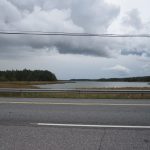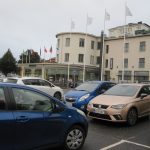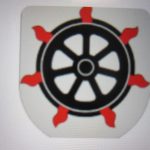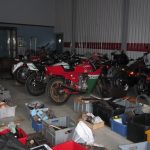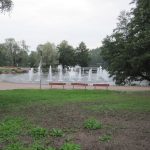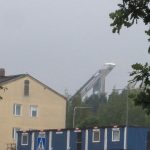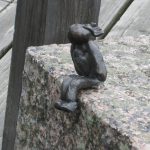Finland 2019
Finland 2019
CLICK ON PICTURES TO ENLARGE
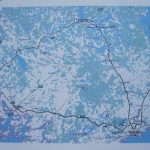 The Finns are mad about cars and mad about museums, so it might be expected that they would be mad about car museums. And they are. During my research for this trip I found records of at least 20 transport museums in Finland, and that is for a population of 5.5 million, less than one tenth of that of Britain. The total time I would be in Finland was five days, which would limit the distance I could travel from Helsinki, and at the beginning of September some places were only open weekends or closed altogether for the winter. Eventually I whittled it down to a list of six good museums that I would be able to get to, and even then it would mean quite a bit of travelling. .
The Finns are mad about cars and mad about museums, so it might be expected that they would be mad about car museums. And they are. During my research for this trip I found records of at least 20 transport museums in Finland, and that is for a population of 5.5 million, less than one tenth of that of Britain. The total time I would be in Finland was five days, which would limit the distance I could travel from Helsinki, and at the beginning of September some places were only open weekends or closed altogether for the winter. Eventually I whittled it down to a list of six good museums that I would be able to get to, and even then it would mean quite a bit of travelling. .
It would be my second visit to Finland, the first being a day trip to Helsinki from Tallinn in Estonia in 2008, reported elsewhere on this site. This time I flew directly from Gatwick with Norwegian, and everything went well until we got off the plane in Helsinki. After walking a very long way we came into the arrivals hall to find a considerable queue which appeared not to be moving at all. Apparently the automatic passport-reading machines had broken down and the few officials present were standing around hoping that they would start working again. After about 15 minutes with an ever-lengthening queue they resorted to good old-fashioned manual processing, and even then they did not exactly rush their backsides off to get people through. Welcome to state-of the art super-efficient Finland.
After a well-organised handover of my Opel Astra from Alamo (the car hire firm, not Texas) I drove to the Hotel AVA in the suburbs of Helsinki. The Finnish capital is considerably further north than my home in England, and I thought it might be colder, but it was more or less the same and remained mild throughout my stay. The area around the hotel might be described as a leafy suburb that could be found in most big cities in Europe, with the exception of one side street which was distinctly Scandinavian in character.
The next morning I set off for Espoo Car Museum. Espoo is a town about 12 miles from Helsinki and the museum is north of the centre near a lake. It could hardly not be near a lake because everywhere in Finland is near a lake, the country is totally peppered with them. By one standard of measurement there are 187,888 of them. Southern Finland has few hills of any height because there isn’t enough room for them between the lakes.
The museum opened at 11.00am and I arrived at 10.30, so I had to wait in a nearby field which was empty apart from a man standing by an immaculate Volvo ‘Amazon’ classic car. Unusually he did not speak much English.
The language
With native English, fluent German and a fair knowledge of French words (though not how to pronounce them or put them together) I can get by in many European countries, but Finnish is very difficult to read or understand when heard. I told one local man that I could not remember Finnish place names, and he said “Neither can we!” Fortunately most people in Finland speak English, usually extremely well. Most public notices are in Finnish and Swedish, often also in English, but surprisingly some of the museums had little in the way of description apart from Finnish.
The museum was oustandingly good, and run by very nice people, as most car museums are. An astonishing collection of cars, motorcycles, mopeds, bicycles and a huge amount of automobilia. A considerable proportion of the exhibits were from eastern Europe and as I left the lady in reception gave me a book about the history of the museum. When I drove away there must have been about 70 Volvo Amazons in the adjacent field, with more still arriving. It was Saturday and an example of the strength of the classic car movement in Finland.
To Kangasala
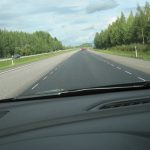 The two museums at Kangasala were about 100miles from Espoo and I cut across to the E12 motorway towards Tampere and then turned off at Hämeenlinna towards Kangasala. The motorway was quite busy at times and there was some rain, but the driving was generally good, as I had expected it to be. The scenery was pleasant enough, though monotonous as motorways often are.
The two museums at Kangasala were about 100miles from Espoo and I cut across to the E12 motorway towards Tampere and then turned off at Hämeenlinna towards Kangasala. The motorway was quite busy at times and there was some rain, but the driving was generally good, as I had expected it to be. The scenery was pleasant enough, though monotonous as motorways often are.
It was very much back into lake country, and the two museums were not far apart, more or less at opposite ends of a causeway over a lake.
Mobilia Museum
Mobilia closed much earlier than Vehonieme, so I went there first. This was an extremely smart museum, in which you could quite safely eat off the floor instead of the tables in the excellent restaurant should you wish to do so. It had a general section of cars and motorcycles plus a large rally car display, as rallying has a big following in Finland. All the exhibits were immaculate and everything was perfect. There were simulators and educational features that were clearly aimed at families rather than people who enjoy getting their hands dirty.
Vehonieme Car Museum
Smaller than the previous two, this museum is attached to a café and gift shop and is run by a family with a very long history of involvement with old vehicles. There are some interesting
exhibits and plans for expansion in the future. They also make special short-run 1:43 scale models.
Nokia
As the next stage would be 93 miles I had booked to stay the night at the Hotelli Iisoppi in the centre of a town with a very famous name - Nokia. It appeared to be more like
a pub with rooms than a hotel, and to be fair it did say on the reservation form ‘Please note that you might experience some noise from the on-site night club during weekends’. The price was reasonable and there were few if any alternatives in the area anyway. Fortunately after my many visits to American motels I always have ear plugs with me, and I certainly needed them. The noise started at 11.00pm and went on until 4.00am.
In the evening I had a walk around Nokia, which is a fairly characterless industrial town. The company of that name still has connections in the town but its headquarters are in Espoo and it has operations all over the world. Despite recent setbacks it is still by far the largest Finnish company.
The next morning I set off for the Uudenkaupungin Automuseo at Uusikkaupunki, so I knew I was definitely in Finland. This was a more scenic route over main roads with little traffic most of the time, despite which the road was being upgraded to dual carriageway for a distance of about 50 miles. In Britain we would think the existing road was more than adequate. There was a vast number of speed cameras, almost of them being recognized by my satnav and in any case I was not driving very fast. Police patrol cars seemed to be non-existent.
A feature of all country roads in Finland is the elk sign, which appears at frequent intervals on the roadside verge. Many years ago the Finns invented the elk test, a swerveability test for cars made famous by the incident in which an original A Series Mercedes fell over containing several journalists, but hitting an elk is definitely something to be avoided. I saw a large number of signs but no elk.
Uudenkaupungin Car Museum
Uusikaupunki is a small place on the west coast and home of another large company called Valmet as well as the museum. Valmet employs about 6000 people, engaged in sub-contract vehicle development and manufacture for Mercedes-Benz, Porsche, Ford, Opel and in the past Saab together with several other firms.
Adjacent to the factory is the Uudenkaupungin museum, which is divided into three sections. The first is a general car and motorcycle collection of a high standard. Then there is the Saab hall, with about 40 cars covering everything from the original 92 through to the GM based models, including a considerable number of rally cars and three Sonnetts. Finally there is a hall for other vehicles and engines made by Valmet. These include an early hybrid electric car called the Fisker Karma made for an American rival to Tesla. About 2000 were produced by Valmet. Also on show is a one-off concept car in the form of a 6-door stretched Talbot Horizon called the Horizonzon, so somebody in the company has a sense of humour. At the time of my visit I was the only person looking round.
Turku
From Valmet I followed the roads close to the coast down to Turku, a large town, noted for its attractive river frontage, harbour and castle. Because I was not sure how my schedule would go I had not booked a hotel in advance, but had noted details of one that looked suitable.
The street that the hotel was in was easy to find but very long, with the number of the hotel at the far end. As I approached the place where it was supposed to be I realized that this was not the best part of town, practically every building having the word SEX on it in some form or other.
Few of the buildings were numbered and I could not locate the hotel, so I parked and walked around to look for it. The street opened up into a square with a big hotel called Helmi on the right hand side, so I decided to see if they had any rooms, which they did but at a higher price than I wanted to pay.
After wandering about for a while and not finding any alternative I threw caution to the winds, booked into the Helmi and went out to find a restaurant. About 50 yards away was a Hesburger, the Finnish rival to McDonalds which can be found at frequent intervals in every town. I always say you can judge the quality of local cuisine anywhere by the number of McDonalds, and in Finland McDonalds have been firmly trounced by Hesburger, which must say something. Anyway, as it was raining hard I went to the Red Chopsticks facing my room at the back of the hotel.
The list of car museums included one called TS Auto Museum on an industrial estate on the north side of Turku, so that was my target the next morning. When I got to the address it appeared to be a derelict factory, and I was sitting in the empty car park deciding what to do when I realised that the Vikings had landed, or at least one of them had. Standing about 50 yards away was a tall young man with light ginger hair and a beard. He was wearing work clothes with an array of mechanic's tools on a belt round his waist. When I asked him if he spoke English he said "A little", but then, as I recollect from school history lessons, on their first visit to England they didn't bother much about languages. They just ran around waving axes and snatched our women. Anyway, he spoke enough to assure me that the car museum had definitely gone.
On the opposite side of the road was a warehouse-type building with several names on it, including MOTONET. It appeared to be something like a larger version of Halfords, and I thought it might be interesting. Within a short time of passing through the door I realised that this was THE BEST SHOP IN THE WORLD. It was not for the man I really am, but for the man I would like to be.
It had everything to do with action, adventure, and the great outdoors, surpassing anything I had seen in the USA, Canada, or anywhere else. Loads of car, motorcycle, huntin,', shootin', fishin' as well as mundane DIY stuff.
Bending down sorting things on the bottom shelf was a young lady with long blonde hair flowing over her shoulders. I asked her where to find something, and she told me in excellent English. She then stood up to her full height of about 6ft 2 in. Was she the sister or wife of the man in the car park? This shop had everything a man could hope for, but in my case, at 81 years old and 5ft 7in, I didn't think I was in with much of a chance.
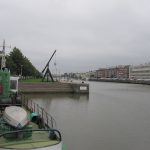 As I had plenty of time I went back into Turku and parked near the river,
As I had plenty of time I went back into Turku and parked near the river,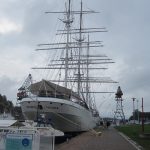 close to the entrance to a marine attraction called Forum Marinum, a riverside museum partly indoors and partly open-air. One of the main features was a large sailing ship undergoing restoration, although it looked pretty immaculate to me. For a short distance I walked along the quayside towards the town centre and came across some tiny bronze figures firmly attached to the concrete. There was no explanation for them.
close to the entrance to a marine attraction called Forum Marinum, a riverside museum partly indoors and partly open-air. One of the main features was a large sailing ship undergoing restoration, although it looked pretty immaculate to me. For a short distance I walked along the quayside towards the town centre and came across some tiny bronze figures firmly attached to the concrete. There was no explanation for them.
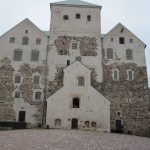 A path parallel to the river in the opposite direction led to the castle, which was closed on that day. It was an extremely Nordic structure, like three narrow towers joined together facing a courtyard with white buildings along both sides.
A path parallel to the river in the opposite direction led to the castle, which was closed on that day. It was an extremely Nordic structure, like three narrow towers joined together facing a courtyard with white buildings along both sides.
I think there was much more to Turku than I saw, but it was time to move on because I had to get to Lahti, a city about 144 miles away, the other side of Helsinki. It was an unpleasant motorway journey,with heavy traffic for a long way round Helsinki, and maybe it would have been better if I had cut across country. On the approach to Lahti there were many out-of-town shops and a fair amount of industry. Again, I did not have a hotel reserved, but had one noted down called the GreenStar and came across it quite by accident on the way into the centre.
Once sorted, I walked into the centre for a meal and look round. Lahti is the regional capital and has a rather unusual coat of arms in the form of a train wheel surrounded by flames. This may be because in the 1870s it was an important railway terminal and was almost totally destroyed by fire in 1877. Or perhaps the Finns just think up coats of arms like that during the long cold winters.
The city is situated at the end of Finland’s second largest lake with a bay that reaches almost into the centre. The lake itself has about 1900 islands, and is linked to the main streets by a park with fountains and a pleasant market square. Towering above the suburbs is the ski jump, which has been used for world championships.
Suomen Moottoripyörämuseo
The reason for going to Lahti was the Finnish Motorcycle Museum which I visited the next morning and was greeted by the friendly owner who had just returned from the annual Ace Café event in Brighton. His museum is affiliated to the Ace Café in London and has an excellent collection of motorcycles from all over Europe and America. In an adjacent building were about 40 motorcycles that he had recently bought from another collector in Finland, and he let me wander around in there. ‘About 40’ was the right description, because a large proportion of them were dismantled and spread around on the floor. He also had a London Routemaster bus for bringing people from the town in the summer.
It was time to go to the airport for my return flight home. On the way I stopped at a big shopping centre for a snack and a look round IKEA, which unsurprisingly was just like the ones in England.
Filling the car with fuel and returning it to Alamo turned into a nightmare, because although I had detailed instructions I got hopelessly lost in the airport, which is amazingly large. It seems to be quite modern, with two terminal buildings joined end-to-end, but I thought it was very poorly designed. It entails a large amount of walking at the end of which you still have to get on a bus to the plane. Gatwick might be dreadful, but at least the long walks usually take you right to the plane. Also, the seating arrangements in the departure lounge were poor, with too few seats, and those were like badly shaped hard benches. How this can be in a country which is famed for its furniture designs I do not know.
In four complete days I visited five museums and drove 600 miles, so I did not have a lot of time for general tourist activities, but I was rather disappointed with the architecture that I saw. Helsinki has many beautiful buildings old and new, but elsewhere a large proportion of buildings are just rectangular blocks with, to my mind, no architectural merit.
To anyone coming from pre-Brexit Britain Finland is incredibly expensive, many things costing at least fifty per cent more than at home. One favourable aspect is that virtually everyone is friendly and welcoming.

